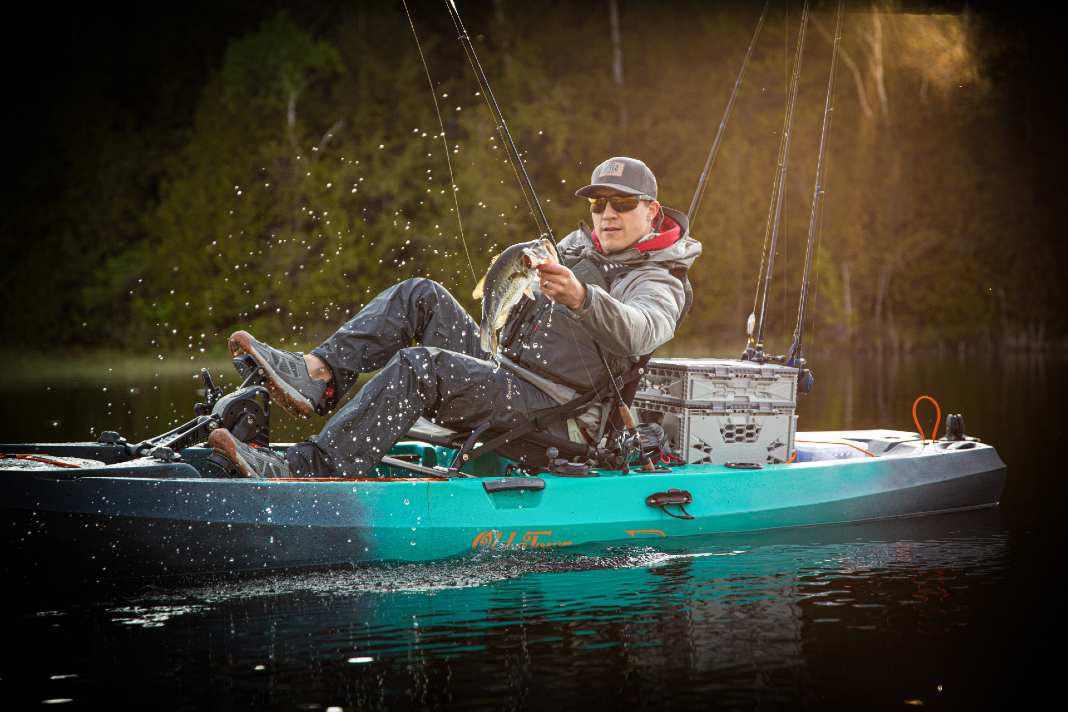Like Forrest and Jenny, Joannie and Chachi or Fred and Ginger, it was only a matter of time before another match was made in heaven. Thermoformed kayaks are light and tough. Pedal drives are all the rage. I’m surprised it took so long to bring the two together with the Pelican Catch 130 HyDryve.
Pelican Catch 130 HyDryve Specs
Length: 12’6”
Width: 34”
Weight: 78 lbs
Capacity: 425 lbs
MSRP: $1,499.99
www.pelicansport.com
Pelican breaks new ground with the Catch 130
Leave it to Pelican International, the thermoform masters, to make the match. Communications chief Renée Brand points out, “We were the first to use thermoform technology to make a kayak and the first to put a pedal drive in a thermoformed kayak.”
You see, most fishing kayaks are made of rotomolded plastic. Pellets are dumped into a mold, the mold is heated, rotated to spread the molten plastic, then cooled. Thermoforming starts with two sheets of plastic heated and molded in a press to create the deck and hull of the kayak. Once the halves cool, they are joined to make a kayak.
Thermoform produces a lighter kayak, but the material is not as thick or stiff as rotomolded plastic. The solution? Pelican uses a hard-plastic insert to hold the pedal system. Renée Brand explains another advantage of the removable insert, “Wear and tear over time will not appear on the kayak hull, but on the housing, which can be easily and inexpensively replaced.”
While I wasn’t surprised to see a thermoformed pedal boat, I was surprised to see Pelican International using a flipper system similar to the first generation Hobie MirageDrive. The company avoided the pitfalls of designing a new-and-improved drive while gaining the advantages of a proven system. Brand adds, the flippers are more friendly to sea grass and vegetation and can be used in protected areas where propellers are forbidden.
Wide and stable with a simple fin drive
It’s been years since I’ve seen a first generation MirageDrive, but the HyDryve seems light and bare, boiled down to the simplest elements: pedals, cranks and fins. But no reverse.

Many users find fin drives easier to propel. They say pushing the pedals forward and back is easier on legs than round and round. And they say flexible fins push more water than propeller blades. So combining the most efficient propulsion method with the lightest kayak should be a match made in heaven.
Pelican installed the HyDryve in their fishing flagship Catch 130. Renée Brand explains, “The tunnel hull is primarily designed for standup fishing.” Even though the boat is stable with razor-edge tracking, the large rudder and powerful pedal system provide sufficient power and handling. In fact, we’d like to see an option for removing the pedal housing and replacing with a solid plug to turn the Catch 130 into a better paddling boat.
Famous for a wide, open deck from stern to bow, the Catch 130 is ripe for standup fishing. Pelican skipped a bow hatch, saved money and installed a well to hold gear, a fishing crate or cooler. A small, day hatch in the stern gives access to the inner workings of the rudder system. The stern well is massive, with enough room for another crate or cooler.

The Catch 130 doesn’t skimp on fishability
The Pelican Catch 130HD is peppered with fishing-ready accessories. I like the three flush mount rod holders behind the seat for vertical rod storage. Another flush mount on the starboard side of the seat is convenient for holding the rod while rigging lures or wrestling with a fish.
Heavy-duty handles on each side of the rudder and in the bow make it easy to carry the Catch 130. I’d like to see handles on either side of the seat, too. Pelican included gear tracks ahead of the seat for rod holders, electronics and other accessories. I’d add gear tracks on either side of the tankwell to secure a crate or add more rod holders.
The Ergocast G2 seat combines mesh and padding for a cool, comfortable ride. Straps on the back and under the seat tighten the mesh to adjust support.
I have to admit, I was pessimistic at the start. The HyDryve pedal system is light and simple, going back to the early days of pedal drives. The insert in the deck seemed suspicious. When I finally put the Catch 130HD on the water, the boat had a lot to prove.

So, I was pleasantly surprised when the system came together perfectly. The drive fits solidly in the well, I didn’t detect significant flex or looseness. Pushing the large, padded pedals produced adequate speed and the rudder easily handled turns. I was able to fish without distractions, the HyDryve is smooth, quiet and powerful for a fast ride.
Pelican’s Catch 130 HyDryve brings it all together
Remembering Pelican’s long history in kayak design, I was reassured by convenient fishing features and solid construction. Even if the HyDryve isn’t most contemporary pedal system, the Pelican Catch 130’s thermoformed construction is light enough to make it a perfect match if you’re looking to spend less than $1,500.
This article was first published in the Summer 2019 issue of Kayak Angler Magazine. Subscribe to Kayak Angler Magazine’s print and digital editions, or browse the archives.
Why didn’t someone think of this before? | Feature Photo: Patrick Buzz Hayes




